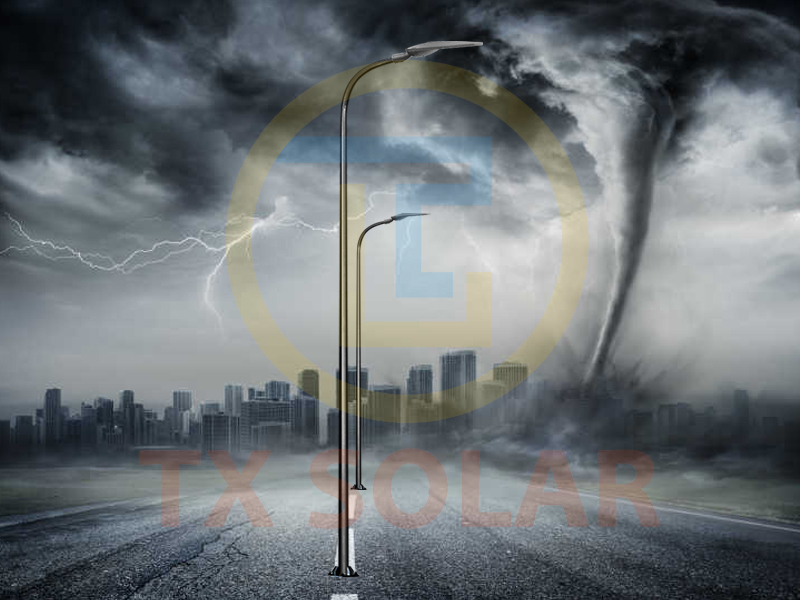Pals de llumtenen un paper important en la nostra vida quotidiana, proporcionant il·luminació a carreteres, aparcaments i llocs públics. Tanmateix, aquestes estructures imponents són susceptibles a la vibració del vent, cosa que crea riscos per a la seguretat i comporta un manteniment i reparacions costoses. En aquest article, explorarem els efectes de la vibració del vent en els pals de llum i discutirem estratègies per evitar aquest efecte.
Impacte de la vibració del vent en els pals de llum
L'impacte de la vibració del vent en els pals de llum pot ser significatiu, especialment en zones propenses a vents forts o condicions meteorològiques extremes. Quan s'exposen a fortes ratxes de vent, els pals de llum poden balancejar-se i vibrar excessivament, causant possibles danys estructurals i comprometre l'estabilitat. Això no només representa un risc per a la seguretat dels vianants i conductors propers, sinó que també pot provocar un mal funcionament del pal de llum.
Un dels factors clau que causen la vibració induïda pel vent als pals de llum és el disseny i la construcció d'aquests pals. En molts casos, els pals de llum estan dissenyats per ser prims i lleugers, cosa que els fa més susceptibles als efectes del vent. A més, els materials utilitzats en la seva estructura (com l'alumini o l'acer) també poden afectar la seva resposta a les càrregues del vent.
Com evitar-ho?
Per mitigar l'impacte de la vibració del vent en els pals de llum, cal prendre mesures proactives durant les fases de disseny, instal·lació i manteniment. Una de les estratègies més efectives és utilitzar tècniques d'enginyeria i analítiques avançades per optimitzar la integritat estructural dels pals de llum. Això pot implicar la realització de proves en túnels de vent i simulacions numèriques per avaluar el seu comportament dinàmic i identificar possibles vulnerabilitats.
A més, l'ús de sistemes d'amortiment i dispositius de control de vibracions ajuda a reduir l'impacte de la vibració del vent sobre els pals de llum. Aquests poden incloure amortidors de massa sintonitzats, amortidors viscosos i altres sistemes passius i actius dissenyats específicament per contrarestar les forces dinàmiques exercides pel vent.
A més del disseny i la construcció, la ubicació d'instal·lació i l'entorn dels pals de llum també poden afectar la seva sensibilitat a la vibració del vent. Per exemple, els pals de llum situats en zones obertes o a prop d'edificis i estructures altes tenen més probabilitats de veure's afectats pel flux d'aire turbulent i els efectes de la càrrega del vent. Per tant, cal tenir en compte les condicions específiques del lloc i els possibles danys del vent a l'hora de seleccionar i instal·lar els pals de llum.
El manteniment i la inspecció regulars dels pals de llum són fonamentals per identificar i abordar els signes de vibració del vent i danys estructurals. Això pot incloure avaluacions visuals, avaluacions estructurals i mètodes d'assaig no destructius per controlar l'estat dels pals de llum i detectar qualsevol anomalia o problema que pugui comprometre la seva estabilitat i seguretat.
Un altre aspecte important a tenir en compte és l'ús de sistemes d'ancoratge i fonamentació adequats per fixar els pals de llum i minimitzar els efectes de la vibració del vent. Això inclou la selecció del disseny de fonamentació adequat, els mètodes d'ancoratge i les condicions del sòl per garantir l'estabilitat del pal i la seva capacitat per suportar les forces del vent.
En resum, els efectes de la vibració del vent sobre els pals de llum poden tenir conseqüències profundes per a la seguretat pública, la integritat de la infraestructura i els costos de manteniment. Si entenem els factors que contribueixen a la vibració induïda pel vent i prenem mesures proactives per abordar aquests factors, podem mitigar els riscos associats als pals de llum i garantir el seu rendiment i fiabilitat a llarg termini. Mitjançant l'ús de tècniques d'enginyeria avançades, dispositius de control de vibracions, consideracions específiques per al lloc i un manteniment regular, podem minimitzar l'impacte de la vibració del vent sobre els pals de llum, millorant en última instància la seguretat i la funcionalitat de l'entorn construït.
Data de publicació: 21 de desembre de 2023

